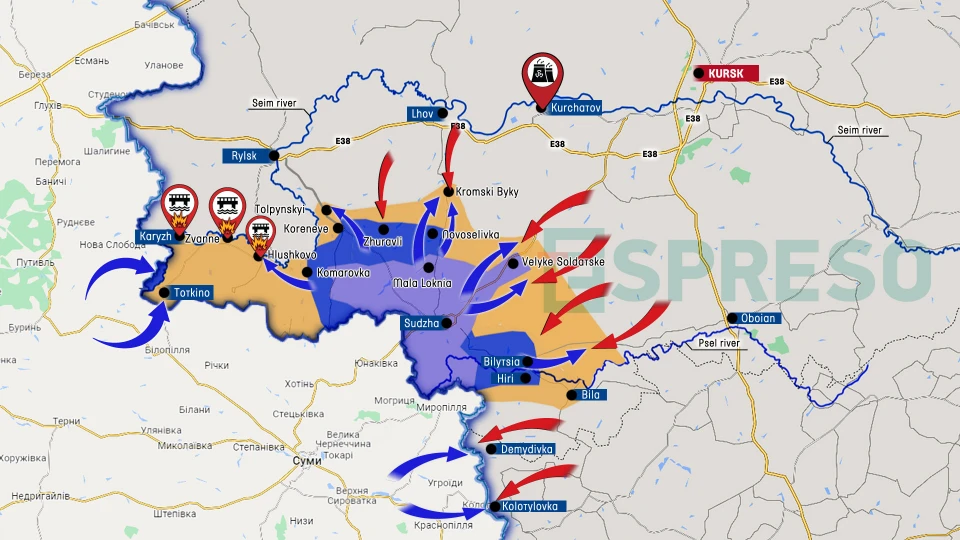
New Ukrainian UAV attack on Russian airfields, Syrskyi's report to Zelenskyy. Serhiy Zgurets' column
On the night of August 22, Ukrainian troops targeted Russian military airfields once more, and the Kursk operation continues. Chief of Staff Syrskyi has reported to Zelenskyy about bolstering defense in the Donetsk region
Attack on Russian military airfields
The Ukrainian Defense Forces have intensified strikes on Russian military airfields, recently hitting the Marinovka air base near Volgograd, 450 kilometers from the front line. This base, used by Russia for bombing operations, housed Su-24MR reconnaissance aircraft and, notably, 15 Su-34 frontline bombers, which were captured on satellite images before the attack. These bombers are crucial for Russia’s precision-guided bombing of Ukrainian defense lines.
That night, the Marinovka airbase was surrounded by a significant number of Ukrainian drones. This led to explosions in warehouses containing aviation KABs, ongoing ammunition detonation, and burning fuel and lubricants. Confirmation of the destruction of some Russian aircraft is still pending.
Details of the “largest attack of Ukrainian drones on Russia”
It was revealed that Ukrainian drones targeted several sites in Russia, as Moscow's leadership described it as the largest drone attack on Moscow and nearby regions. Kyrylo Budanov, head of Ukraine's Main Intelligence Directorate, shared details with The War Zone, which often receives information from him faster than Ukrainian media. Budanov indicated that the drones struck a radio intelligence center (details unspecified), an airport, and an air base on the night of August 21.
For this operation, 50 drones were deployed, with the attack on the Ostafyevo airfield serving as a diversion. The primary target was the radio intelligence center in the Moscow region. Briefly, it is a site that was established during the Soviet era and has been continuously upgraded. It was designed to monitor the flights of NATO and U.S. strategic and reconnaissance aircraft. Currently, it is actively used by Russian intelligence to analyze airspace. These strikes represent a systematic operation of unmanned systems organized and executed by the Defence Intelligence of Ukraine.
Front line update
Volodymyr Zelenskyy and Oleksandr Syrskyi recently visited the Sumy region, where the chief of the army reported further Ukrainian advances in the Kursk region. Zelenskyy mentioned that another settlement had been captured but did not specify its name. It is likely that the settlement in question is Krasnooktyabrsky, which effectively isolates a group of Russian troops positioned between the Seim River and the state border to the east. Following recent attacks on bridges and pontoons, these Russian forces now face a critical decision: continue defending their position or attempt to withdraw across the river.

It is also significant that Syrskyi reported to Zelenskyy on measures to strengthen defense in the Toretsk and Pokrovsk directions, where the Russian army is advancing, albeit slowly. This commitment to bolstering defense in these areas could yield tangible results in deterring Russia's advance, as additional forces and resources are being deployed by the leadership of the Ukrainian Armed Forces and the Defense Forces.

Ukrainian weapons development
Ukrainian development companies are providing a great deal of support to Ukraine's defense forces. Kateryna Mykhalko, executive director of the Technological Forces of Ukraine association, spoke about their work.
“The Technological Forces of Ukraine unites almost 4 dozen powerful Ukrainian manufacturers: all the largest manufacturers of drones, UAVs, ground drones, marine drones and FPVs, of course. Also, components for these drones, ammunition, and other innovative Ukrainian developments that strengthen the front line and give Ukraine an advantage. We were created to strengthen the industry, to strengthen those who help defend Ukraine. We are developing recommendations for legislation, making sure that arms production and contracting work more efficiently, and that our military receives the best weapons quickly, easily and affordably,” she says.
Kateryna Mykhalko also said that there is a problem of predictability of contracting in Ukraine. She noted that the country critically needs state contracts for 2-3 years in advance for Ukrainian weapons. According to her, there are still problems with this, and predictable weapons are not contracted due to budget year restrictions and other challenges.
“We are now in a dialog with the state customer to fix this. Closed exports are also a challenge, because when Ukrainian weapons do not come into contact as expected, when there is underutilization of the capabilities of Ukrainian companies, of course, exports would be auxiliary and help Ukraine become a richer country and have foreign exchange earnings within the country. The topic of exports has progressed a bit, and we hope that the government will hear us, open exports for surplus products, for products that our army does not need, so that Ukrainian businesses can stay in Ukraine, not go abroad and strengthen our defense capabilities,” she said.
Some companies that are part of the Technological Forces of Ukraine association have branches abroad, some are going to leave, and some believe that this is irrational and wrong. Kateryna Mykhalko said that the association recently conducted a survey among companies. The figures showed that 85% of companies have already relocated their facilities or are planning to do so. According to her, the main reasons are closed exports - this is the number one reason that everyone cites. Other reasons include the absence of government contracts or their insufficient number, lack of working capital at enterprises, which makes it impossible to invest resources in the latest developments: “We are drawing the state's attention to this, asking it to resolve these issues, because it will be very sad if these companies leave Ukraine. And at some point, if the situation is not corrected, they will do so. And we will lose such a great potential that we have all gained together at a terrible price.”
When a company opens a branch or establishes a base abroad, it is not limited to exports and does not face constant inspections. Thus, it has more flexibility in interacting with foreign partners.
“The company gets access to the global market. Moreover, we draw the state's attention to the fact that when one drone is not allowed to leave the country, when export controls prohibit the export of one drone, it leads to the company thinking about packing its bags and moving the entire enterprise. It is much more rational for the state to release one-off products temporarily for exhibitions or one-off sales than to lose an entire enterprise. In addition, there is still an advantage of importers over the Ukrainian private sector in Ukraine, which is absolutely terrible. As a state, we should give preference to Ukrainian local producers, we should have protectionism towards our business,” said Kateryna Mykhalko.
She noted that Ukrainian weapons on the Ukrainian front are performing better than Western models because Ukrainian engineers understand the specifics of the Ukrainian war and what needs to be done to defend the country. Western companies don't always have this understanding, so their models don't work as well. At the same time, she said, they are able to ship a lot of equipment from warehouses because they have more resources than Ukrainian companies. Accordingly, a Ukrainian customer sometimes decides to quickly buy certain equipment and import it from abroad because it is in warehouses there, while Ukrainian manufacturers have nothing in their warehouses, said Mykhalko.
“That's why we draw the attention of state customers - the SSSCIP (State Service for Special Communications and Information Protection - ed.), the Defense Procurement Agency - to the fact that if they suddenly have additional procurement budgets at the end of the year, please do not hesitate to use them. This may happen, then please sign transitional contracts with Ukrainian manufacturers, but do not contact importers at an inflated cost just because they can supply equipment immediately from warehouses,” she emphasized.
Mykhalko also noted that the Technological Force of Ukraine is trying to communicate with all state authorities. She noted that the Economic Committee of the Parliament is actively involved in the process of possible export opening. They also communicate with the Ministry of Defense and the Ministry of Strategic Industries.
“According to our survey, 98% of enterprises said that at least half of their production capacity is idle. And only 35%, if I'm not mistaken, have fully utilized their capacities, meaning that the state has something to contract,” she added.
- News












































